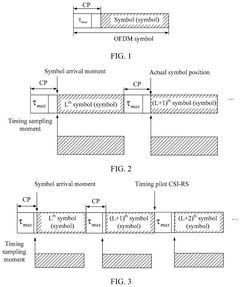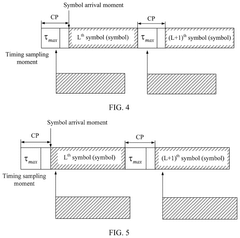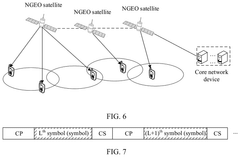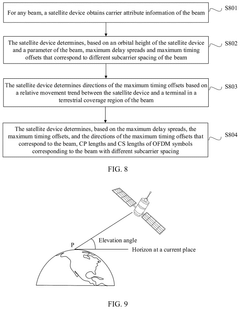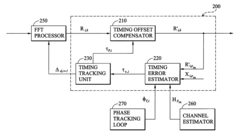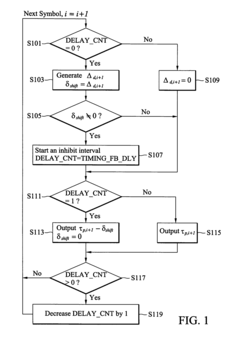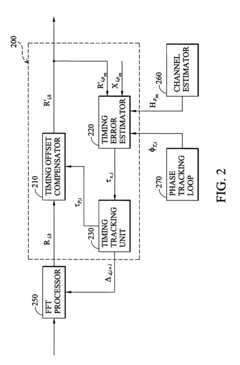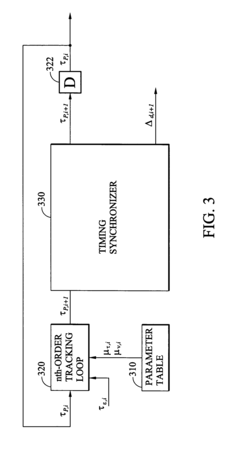How to Use OFDM for Reliable Satellite Communication
SEP 12, 20259 MIN READ
Generate Your Research Report Instantly with AI Agent
Patsnap Eureka helps you evaluate technical feasibility & market potential.
OFDM Satellite Communication Background and Objectives
Orthogonal Frequency Division Multiplexing (OFDM) has emerged as a pivotal technology in modern communication systems due to its robust performance in challenging channel conditions. The evolution of satellite communication has witnessed significant technological advancements since the launch of the first artificial satellite, Sputnik 1, in 1957. Traditional satellite communication systems primarily relied on single-carrier modulation techniques, which faced limitations in combating frequency-selective fading and inter-symbol interference.
The integration of OFDM into satellite communication represents a natural progression in addressing these challenges. OFDM's multicarrier approach divides the available spectrum into multiple orthogonal subcarriers, each modulated at a lower data rate, thereby enhancing resilience against frequency-selective fading and enabling more efficient spectrum utilization. This technical evolution aligns with the growing demand for higher data throughput and more reliable communication links in satellite networks.
The satellite communication landscape has been transformed by increasing demands for broadband connectivity, IoT applications, and global coverage requirements. These market forces have accelerated the need for more sophisticated modulation techniques that can deliver higher spectral efficiency while maintaining robustness in the unique challenges posed by satellite channels, including long propagation delays, Doppler shifts, and atmospheric effects.
Recent technological trends indicate a shift toward more flexible and adaptive communication systems. The development of software-defined satellites and reconfigurable payloads has created new opportunities for implementing advanced modulation schemes like OFDM. Additionally, the emergence of Low Earth Orbit (LEO) satellite constellations has introduced new dynamics to the satellite communication ecosystem, necessitating modulation techniques that can handle rapid changes in channel conditions.
The primary technical objectives for implementing OFDM in satellite communication include enhancing spectral efficiency to maximize data throughput within limited bandwidth allocations, improving resilience against channel impairments specific to satellite links, reducing power consumption to extend satellite operational lifespans, and ensuring compatibility with existing terrestrial OFDM-based standards to facilitate seamless integration.
Furthermore, the goal is to develop OFDM variants specifically optimized for satellite channels, addressing unique challenges such as non-linear distortion from high-power amplifiers, increased phase noise, and significant Doppler shifts. These specialized adaptations aim to maintain OFDM's inherent advantages while mitigating its potential weaknesses in satellite environments.
The convergence of satellite and terrestrial networks, particularly in the context of 5G and beyond, presents another critical objective: creating unified communication standards that can operate seamlessly across different network segments. OFDM's widespread adoption in terrestrial systems makes it a strong candidate for this unified approach, potentially simplifying network architecture and reducing implementation costs.
The integration of OFDM into satellite communication represents a natural progression in addressing these challenges. OFDM's multicarrier approach divides the available spectrum into multiple orthogonal subcarriers, each modulated at a lower data rate, thereby enhancing resilience against frequency-selective fading and enabling more efficient spectrum utilization. This technical evolution aligns with the growing demand for higher data throughput and more reliable communication links in satellite networks.
The satellite communication landscape has been transformed by increasing demands for broadband connectivity, IoT applications, and global coverage requirements. These market forces have accelerated the need for more sophisticated modulation techniques that can deliver higher spectral efficiency while maintaining robustness in the unique challenges posed by satellite channels, including long propagation delays, Doppler shifts, and atmospheric effects.
Recent technological trends indicate a shift toward more flexible and adaptive communication systems. The development of software-defined satellites and reconfigurable payloads has created new opportunities for implementing advanced modulation schemes like OFDM. Additionally, the emergence of Low Earth Orbit (LEO) satellite constellations has introduced new dynamics to the satellite communication ecosystem, necessitating modulation techniques that can handle rapid changes in channel conditions.
The primary technical objectives for implementing OFDM in satellite communication include enhancing spectral efficiency to maximize data throughput within limited bandwidth allocations, improving resilience against channel impairments specific to satellite links, reducing power consumption to extend satellite operational lifespans, and ensuring compatibility with existing terrestrial OFDM-based standards to facilitate seamless integration.
Furthermore, the goal is to develop OFDM variants specifically optimized for satellite channels, addressing unique challenges such as non-linear distortion from high-power amplifiers, increased phase noise, and significant Doppler shifts. These specialized adaptations aim to maintain OFDM's inherent advantages while mitigating its potential weaknesses in satellite environments.
The convergence of satellite and terrestrial networks, particularly in the context of 5G and beyond, presents another critical objective: creating unified communication standards that can operate seamlessly across different network segments. OFDM's widespread adoption in terrestrial systems makes it a strong candidate for this unified approach, potentially simplifying network architecture and reducing implementation costs.
Market Analysis for OFDM-based Satellite Services
The global market for OFDM-based satellite communication services is experiencing significant growth, driven by increasing demand for high-speed connectivity in remote and mobile environments. Current market valuations indicate the satellite communication sector is worth approximately 25 billion USD, with OFDM-specific implementations accounting for a growing segment estimated at 7 billion USD annually. Industry forecasts project a compound annual growth rate of 14.3% for OFDM satellite technologies through 2028, outpacing traditional satellite communication methods.
Consumer broadband represents the largest market segment, with over 2.5 million subscribers worldwide utilizing OFDM-based satellite services for internet connectivity. This segment is particularly strong in rural and underserved regions where terrestrial infrastructure is limited. North America leads with 42% market share, followed by Europe at 28% and Asia-Pacific at 21%.
The maritime and aviation sectors demonstrate the highest growth potential, with adoption rates increasing by 22% annually as vessels and aircraft require reliable broadband connectivity regardless of location. Military and defense applications constitute approximately 18% of the total market, valued at 1.3 billion USD, with stringent requirements for secure and resilient communications driving premium pricing structures.
Enterprise solutions, particularly for energy, mining, and construction industries operating in remote locations, represent another significant market segment with 15% market share. These industries prioritize reliability and throughput capabilities that OFDM technology effectively delivers under challenging environmental conditions.
Market research indicates customer willingness to pay premium prices for OFDM-based satellite services that offer higher throughput and reliability compared to conventional systems. Average revenue per user (ARPU) in the consumer segment ranges from 70-120 USD monthly, while enterprise customers typically invest 2,000-5,000 USD monthly depending on bandwidth requirements and service level agreements.
Competitive analysis reveals increasing market consolidation, with five major providers controlling 73% of the global OFDM satellite service market. Recent merger and acquisition activity suggests continued consolidation as companies seek to achieve economies of scale and expand service portfolios.
Regulatory environments vary significantly by region, with spectrum allocation and licensing requirements presenting market entry barriers in certain territories. The International Telecommunication Union's recent spectrum allocations have created new opportunities for OFDM-based satellite services, particularly in Ka and Ku bands, potentially opening an additional 3 billion USD market opportunity over the next five years.
Consumer broadband represents the largest market segment, with over 2.5 million subscribers worldwide utilizing OFDM-based satellite services for internet connectivity. This segment is particularly strong in rural and underserved regions where terrestrial infrastructure is limited. North America leads with 42% market share, followed by Europe at 28% and Asia-Pacific at 21%.
The maritime and aviation sectors demonstrate the highest growth potential, with adoption rates increasing by 22% annually as vessels and aircraft require reliable broadband connectivity regardless of location. Military and defense applications constitute approximately 18% of the total market, valued at 1.3 billion USD, with stringent requirements for secure and resilient communications driving premium pricing structures.
Enterprise solutions, particularly for energy, mining, and construction industries operating in remote locations, represent another significant market segment with 15% market share. These industries prioritize reliability and throughput capabilities that OFDM technology effectively delivers under challenging environmental conditions.
Market research indicates customer willingness to pay premium prices for OFDM-based satellite services that offer higher throughput and reliability compared to conventional systems. Average revenue per user (ARPU) in the consumer segment ranges from 70-120 USD monthly, while enterprise customers typically invest 2,000-5,000 USD monthly depending on bandwidth requirements and service level agreements.
Competitive analysis reveals increasing market consolidation, with five major providers controlling 73% of the global OFDM satellite service market. Recent merger and acquisition activity suggests continued consolidation as companies seek to achieve economies of scale and expand service portfolios.
Regulatory environments vary significantly by region, with spectrum allocation and licensing requirements presenting market entry barriers in certain territories. The International Telecommunication Union's recent spectrum allocations have created new opportunities for OFDM-based satellite services, particularly in Ka and Ku bands, potentially opening an additional 3 billion USD market opportunity over the next five years.
Current OFDM Satellite Technology Challenges
Despite the proven effectiveness of OFDM in terrestrial communications, its implementation in satellite environments presents several significant challenges. The primary obstacle stems from the inherent characteristics of satellite channels, which exhibit longer propagation delays, higher Doppler shifts, and more severe phase noise compared to terrestrial counterparts. These factors can severely compromise the orthogonality of subcarriers, leading to inter-carrier interference (ICI) and degraded system performance.
The Doppler effect poses a particularly formidable challenge in satellite communications utilizing OFDM. With relative velocities between satellites and ground stations potentially reaching several kilometers per second, frequency shifts can exceed the subcarrier spacing, causing significant ICI. This issue becomes even more pronounced in Low Earth Orbit (LEO) satellite constellations, where satellites move rapidly relative to ground stations.
Phase noise introduced by satellite transponders and oscillators represents another critical challenge. OFDM systems are inherently sensitive to phase noise, which can disrupt the phase coherence necessary for proper signal demodulation. In satellite environments, where high-power amplifiers and frequency converters introduce additional phase distortions, maintaining phase integrity becomes exceptionally difficult.
Power efficiency presents a third major hurdle. OFDM signals typically exhibit high peak-to-average power ratios (PAPR), requiring power amplifiers to operate with significant back-off to avoid nonlinear distortion. This requirement conflicts with the need for power efficiency in satellite systems, where power resources are strictly limited. The resulting trade-off between linearity and efficiency significantly impacts system design and performance.
Channel estimation and synchronization also present substantial technical difficulties. The long propagation delays in satellite links complicate timing synchronization, while the dynamic nature of satellite channels necessitates frequent channel estimation updates. These requirements increase system complexity and overhead, potentially reducing spectral efficiency.
Regulatory and standardization challenges further complicate OFDM implementation in satellite communications. Different frequency bands are subject to varying regulations across different regions, and existing satellite communication standards may not fully accommodate OFDM-based systems. This fragmented regulatory landscape impedes widespread adoption and interoperability.
Finally, hardware limitations constrain OFDM satellite implementations. Satellite payloads face strict size, weight, and power (SWaP) constraints, limiting the computational resources available for complex signal processing. Additionally, radiation-hardened components necessary for space environments often lag behind their terrestrial counterparts in processing capability, further restricting the implementation of sophisticated OFDM techniques.
The Doppler effect poses a particularly formidable challenge in satellite communications utilizing OFDM. With relative velocities between satellites and ground stations potentially reaching several kilometers per second, frequency shifts can exceed the subcarrier spacing, causing significant ICI. This issue becomes even more pronounced in Low Earth Orbit (LEO) satellite constellations, where satellites move rapidly relative to ground stations.
Phase noise introduced by satellite transponders and oscillators represents another critical challenge. OFDM systems are inherently sensitive to phase noise, which can disrupt the phase coherence necessary for proper signal demodulation. In satellite environments, where high-power amplifiers and frequency converters introduce additional phase distortions, maintaining phase integrity becomes exceptionally difficult.
Power efficiency presents a third major hurdle. OFDM signals typically exhibit high peak-to-average power ratios (PAPR), requiring power amplifiers to operate with significant back-off to avoid nonlinear distortion. This requirement conflicts with the need for power efficiency in satellite systems, where power resources are strictly limited. The resulting trade-off between linearity and efficiency significantly impacts system design and performance.
Channel estimation and synchronization also present substantial technical difficulties. The long propagation delays in satellite links complicate timing synchronization, while the dynamic nature of satellite channels necessitates frequent channel estimation updates. These requirements increase system complexity and overhead, potentially reducing spectral efficiency.
Regulatory and standardization challenges further complicate OFDM implementation in satellite communications. Different frequency bands are subject to varying regulations across different regions, and existing satellite communication standards may not fully accommodate OFDM-based systems. This fragmented regulatory landscape impedes widespread adoption and interoperability.
Finally, hardware limitations constrain OFDM satellite implementations. Satellite payloads face strict size, weight, and power (SWaP) constraints, limiting the computational resources available for complex signal processing. Additionally, radiation-hardened components necessary for space environments often lag behind their terrestrial counterparts in processing capability, further restricting the implementation of sophisticated OFDM techniques.
Current OFDM Implementation Solutions for Satellites
01 Error correction techniques for OFDM reliability
Various error correction techniques are employed to enhance the reliability of OFDM systems. These include forward error correction (FEC) coding, interleaving, and advanced coding schemes that help recover data corrupted during transmission. These techniques provide robustness against channel impairments, noise, and interference, significantly improving the bit error rate performance of OFDM systems in challenging wireless environments.- Error correction and coding techniques for OFDM reliability: Various error correction and coding techniques are employed to enhance the reliability of OFDM systems. These include forward error correction (FEC), channel coding, interleaving, and advanced error correction algorithms that help mitigate the effects of noise, interference, and channel fading. These techniques improve data integrity and reduce bit error rates in OFDM transmissions, making the system more robust against adverse channel conditions.
- Channel estimation and equalization for OFDM systems: Accurate channel estimation and equalization are crucial for reliable OFDM communications. Advanced channel estimation techniques use pilot signals, training sequences, and adaptive algorithms to assess channel conditions in real-time. Equalization methods compensate for channel distortions, frequency selectivity, and timing offsets. Together, these approaches ensure that OFDM systems can maintain reliable performance even in challenging propagation environments with multipath fading and interference.
- MIMO-OFDM techniques for enhanced reliability: Multiple-Input Multiple-Output (MIMO) technology combined with OFDM significantly improves system reliability through spatial diversity and multiplexing. MIMO-OFDM systems use multiple antennas at both transmitter and receiver to create parallel communication channels, providing redundancy and increased data throughput. This approach offers improved resistance to fading, better spectral efficiency, and enhanced signal quality, particularly in environments with high multipath propagation.
- Adaptive modulation and resource allocation in OFDM: Adaptive modulation and resource allocation techniques dynamically adjust transmission parameters based on channel conditions to maintain reliability. These methods include adaptive bit loading, power allocation, subcarrier assignment, and modulation scheme selection. By continuously monitoring channel quality indicators and adjusting parameters accordingly, OFDM systems can optimize the trade-off between data rate and reliability, ensuring robust performance across varying channel conditions.
- Synchronization and interference mitigation in OFDM: Reliable OFDM operation depends on precise synchronization and effective interference management. Advanced techniques for time and frequency synchronization help maintain orthogonality between subcarriers, while interference mitigation methods address issues like inter-carrier interference (ICI), inter-symbol interference (ISI), and external interference sources. These approaches include guard intervals, cyclic prefixes, windowing techniques, and adaptive filtering, all contributing to more reliable OFDM transmission in challenging wireless environments.
02 Channel estimation and equalization for OFDM systems
Accurate channel estimation and equalization are crucial for reliable OFDM transmission. Advanced algorithms are used to estimate channel characteristics and compensate for distortions caused by multipath fading and frequency selectivity. These methods typically involve pilot-based estimation, interpolation techniques, and adaptive equalization to track time-varying channel conditions, thereby enhancing signal quality and system reliability.Expand Specific Solutions03 MIMO-OFDM techniques for reliability enhancement
Multiple-Input Multiple-Output (MIMO) technology combined with OFDM significantly improves system reliability through spatial diversity and multiplexing. By using multiple antennas at both transmitter and receiver, MIMO-OFDM systems can overcome fading, increase data throughput, and enhance signal quality. Advanced precoding, beamforming, and space-time coding techniques further optimize performance in varying channel conditions.Expand Specific Solutions04 Synchronization methods for reliable OFDM transmission
Robust synchronization techniques are essential for maintaining OFDM reliability. These include methods for timing synchronization, frequency offset estimation and correction, and phase tracking. Advanced algorithms detect and compensate for synchronization errors that can cause inter-carrier interference and degrade system performance. Efficient synchronization ensures proper subcarrier orthogonality and enables reliable data recovery even in challenging propagation environments.Expand Specific Solutions05 Adaptive modulation and coding for OFDM reliability
Adaptive modulation and coding schemes dynamically adjust transmission parameters based on channel conditions to maintain reliability. These techniques select appropriate modulation orders and coding rates according to signal-to-noise ratio measurements, allowing OFDM systems to optimize the trade-off between data rate and error performance. By adapting to changing channel conditions, these methods ensure consistent reliability while maximizing spectral efficiency across varying wireless environments.Expand Specific Solutions
Leading Satellite Communication Industry Players
The OFDM satellite communication market is currently in a growth phase, with increasing demand for reliable high-bandwidth satellite connectivity. The market is projected to expand significantly as satellite communications become essential for global connectivity, with key players including both traditional satellite companies (ViaSat, Hughes Network Systems) and telecommunications giants (Huawei, Ericsson, ZTE). Technical maturity varies across competitors, with established players like Samsung Electronics and Huawei demonstrating advanced OFDM implementations for satellite applications, while research institutions such as Beijing University of Posts & Telecommunications and Electronics & Telecommunications Research Institute are driving innovation in modulation techniques and interference mitigation. The technology is approaching maturity for certain applications but continues to evolve for specialized satellite communication scenarios requiring enhanced reliability.
Huawei Technologies Co., Ltd.
Technical Solution: Huawei has developed an innovative OFDM-based satellite communication solution that addresses the unique challenges of satellite environments. Their approach incorporates a multi-layer adaptive modulation and coding scheme that dynamically adjusts to changing channel conditions, essential for maintaining reliable links through atmospheric disturbances. Huawei's implementation features specialized synchronization algorithms designed to handle the significant propagation delays (typically 250-500ms for GEO satellites) and Doppler shifts inherent in satellite communications. Their system employs an extended cyclic prefix configuration that effectively mitigates the impact of multipath propagation and timing offsets across long-distance satellite links. Additionally, Huawei has implemented advanced frequency domain equalization techniques that compensate for channel distortions while minimizing computational complexity, making their solution suitable for deployment in resource-constrained satellite payloads. The company has also developed proprietary interference cancellation algorithms that significantly improve performance in congested orbital slots where adjacent satellite interference is problematic.
Strengths: Huawei's solution demonstrates exceptional spectral efficiency while maintaining reliability across varying atmospheric conditions. Their implementation is highly adaptable to different satellite orbits (GEO, MEO, LEO) with minimal reconfiguration. Weaknesses: The sophisticated signal processing requirements may increase power consumption, potentially challenging for smaller satellite platforms. Their solution also requires more complex ground segment equipment compared to traditional modulation schemes, potentially increasing deployment costs.
Telefonaktiebolaget LM Ericsson
Technical Solution: Ericsson has developed a comprehensive OFDM-based satellite communication framework that addresses the reliability challenges in non-terrestrial networks. Their approach integrates satellite communications with 5G NTN (Non-Terrestrial Networks) standards, leveraging OFDM's inherent advantages while adapting it specifically for satellite environments. Ericsson's implementation features variable subcarrier spacing configurations (from 15kHz to 120kHz) that can be dynamically selected based on orbital parameters and service requirements. Their system employs sophisticated timing advance mechanisms to compensate for the significant propagation delays in satellite links, which can range from 2-20ms for LEO constellations to over 250ms for GEO satellites. Additionally, Ericsson has developed specialized channel estimation algorithms that account for the rapid channel variations caused by satellite movement, particularly in LEO constellations where Doppler shifts are most pronounced. Their technology incorporates advanced beam management techniques that maintain connectivity during satellite handovers, a critical requirement for ensuring uninterrupted service in non-geostationary satellite systems.
Strengths: Ericsson's solution offers seamless integration with terrestrial 5G networks, enabling unified service delivery across satellite and ground-based infrastructure. Their implementation demonstrates excellent performance in mobility scenarios, maintaining reliable connections even with rapidly moving terminals. Weaknesses: The complexity of their system requires significant processing resources, potentially limiting applicability in smaller satellite platforms with strict power constraints. Their approach also necessitates more sophisticated terminal equipment compared to traditional satellite communication systems.
Key OFDM Satellite Communication Patents and Research
Signal transmission method based on satellite communication and device
PatentActiveUS12119972B2
Innovation
- The proposed method involves determining a dynamic CP length and CS length for OFDM symbols based on carrier attribute information, such as subcarrier spacing, beam identifier, and beam elevation angle, to adjust the OFDM symbol structure and avoid interference, thereby improving resource utilization and reducing bit error rates.
Timing offset compensation in orthogonal frequency division multiplexing systems
PatentInactiveUS7251283B2
Innovation
- A timing offset compensation apparatus comprising a timing error estimator and a timing tracking unit, which uses a parameter table, an nth-order tracking loop, and a timing synchronizer to calculate timing error values and adjust the DFT window, enabling rapid acquisition and continuous tracking of OFDM signals.
Space Environment Effects on OFDM Signal Integrity
The space environment presents unique challenges for OFDM signal transmission in satellite communications. Signal propagation through the ionosphere and various atmospheric layers introduces significant phase shifts and amplitude variations. These effects are particularly pronounced in Low Earth Orbit (LEO) and Medium Earth Orbit (MEO) satellite systems, where signals must traverse multiple atmospheric layers with varying electron densities and compositions.
Ionospheric scintillation represents one of the most severe threats to OFDM signal integrity, causing rapid fluctuations in signal amplitude and phase. These fluctuations can disrupt the orthogonality between subcarriers, leading to inter-carrier interference (ICI) and degraded system performance. Research indicates that scintillation effects are most severe near the geomagnetic equator and in polar regions, with peak activity occurring during solar maximum periods.
Doppler shifts present another critical challenge for satellite-based OFDM systems. The relative motion between satellites and ground stations introduces frequency offsets that can compromise subcarrier orthogonality. For LEO satellites moving at velocities of approximately 7.8 km/s, Doppler shifts can reach ±140 kHz at Ka-band frequencies, significantly exceeding the typical subcarrier spacing in conventional OFDM systems.
Multipath fading in satellite channels differs substantially from terrestrial environments. While less severe in terms of delay spread, satellite multipath components often arrive with greater power variations due to reflections from large geographical features or man-made structures. These multipath components can cause frequency-selective fading across the OFDM bandwidth, affecting certain subcarriers more severely than others.
Thermal noise and interference sources unique to space communications further compromise OFDM signal integrity. Solar radiation, cosmic background radiation, and interference from adjacent satellite systems all contribute to elevated noise floors. The vacuum of space also creates thermal management challenges for satellite transponders, potentially leading to phase noise and nonlinear distortion in OFDM signal amplification.
Time-varying channel characteristics represent perhaps the most challenging aspect of satellite OFDM communications. Unlike relatively stable terrestrial channels, satellite channels can experience rapid variations due to atmospheric conditions, satellite movement, and changes in elevation angle. These variations can render channel estimation techniques ineffective if not properly designed to track and adapt to the dynamic space environment.
Ionospheric scintillation represents one of the most severe threats to OFDM signal integrity, causing rapid fluctuations in signal amplitude and phase. These fluctuations can disrupt the orthogonality between subcarriers, leading to inter-carrier interference (ICI) and degraded system performance. Research indicates that scintillation effects are most severe near the geomagnetic equator and in polar regions, with peak activity occurring during solar maximum periods.
Doppler shifts present another critical challenge for satellite-based OFDM systems. The relative motion between satellites and ground stations introduces frequency offsets that can compromise subcarrier orthogonality. For LEO satellites moving at velocities of approximately 7.8 km/s, Doppler shifts can reach ±140 kHz at Ka-band frequencies, significantly exceeding the typical subcarrier spacing in conventional OFDM systems.
Multipath fading in satellite channels differs substantially from terrestrial environments. While less severe in terms of delay spread, satellite multipath components often arrive with greater power variations due to reflections from large geographical features or man-made structures. These multipath components can cause frequency-selective fading across the OFDM bandwidth, affecting certain subcarriers more severely than others.
Thermal noise and interference sources unique to space communications further compromise OFDM signal integrity. Solar radiation, cosmic background radiation, and interference from adjacent satellite systems all contribute to elevated noise floors. The vacuum of space also creates thermal management challenges for satellite transponders, potentially leading to phase noise and nonlinear distortion in OFDM signal amplification.
Time-varying channel characteristics represent perhaps the most challenging aspect of satellite OFDM communications. Unlike relatively stable terrestrial channels, satellite channels can experience rapid variations due to atmospheric conditions, satellite movement, and changes in elevation angle. These variations can render channel estimation techniques ineffective if not properly designed to track and adapt to the dynamic space environment.
Regulatory Framework for Satellite Spectrum Allocation
The regulatory landscape governing satellite spectrum allocation is a critical framework that directly impacts the implementation of OFDM technology in satellite communications. The International Telecommunication Union (ITU) serves as the primary global authority responsible for coordinating spectrum allocation through its Radiocommunication Sector (ITU-R). The ITU-R manages the Radio Regulations, an international treaty that defines how radio frequency spectrum is allocated across different services, including satellite communications.
For OFDM-based satellite systems, operators must navigate a complex web of frequency bands allocated specifically for satellite services. These include C-band (4-8 GHz), Ku-band (12-18 GHz), Ka-band (26.5-40 GHz), and increasingly, Q/V bands (40-75 GHz). Each band carries distinct regulatory requirements and technical considerations that affect OFDM implementation parameters such as subcarrier spacing and guard intervals.
National regulatory bodies like the Federal Communications Commission (FCC) in the United States, the European Conference of Postal and Telecommunications Administrations (CEPT) in Europe, and similar organizations worldwide implement ITU regulations while adding country-specific requirements. These national frameworks often include licensing procedures, technical standards compliance, and interference mitigation obligations that satellite operators must satisfy before deploying OFDM-based systems.
Cross-border coordination represents another regulatory challenge, as satellite footprints typically span multiple countries. The ITU coordination process requires operators to file advance publication information (API) and coordinate with potentially affected administrations to prevent harmful interference. For OFDM satellite systems, this coordination becomes particularly important due to the technology's sensitivity to interference in adjacent channels.
Spectrum sharing mechanisms are increasingly being incorporated into regulatory frameworks to maximize efficient use of limited orbital and spectrum resources. These include dynamic spectrum access, coordinated frequency assignments, and power flux density (PFD) limits. OFDM's inherent flexibility in adapting to available spectrum makes it well-suited for these emerging regulatory approaches.
Recent regulatory trends show a move toward higher frequency bands (Ka, Q/V) to accommodate growing bandwidth demands. This shift presents both opportunities and challenges for OFDM implementation, as these bands offer wider bandwidths but face greater atmospheric attenuation. Regulatory frameworks are evolving to address these technical realities while promoting innovation in satellite communications technology.
For OFDM-based satellite systems, operators must navigate a complex web of frequency bands allocated specifically for satellite services. These include C-band (4-8 GHz), Ku-band (12-18 GHz), Ka-band (26.5-40 GHz), and increasingly, Q/V bands (40-75 GHz). Each band carries distinct regulatory requirements and technical considerations that affect OFDM implementation parameters such as subcarrier spacing and guard intervals.
National regulatory bodies like the Federal Communications Commission (FCC) in the United States, the European Conference of Postal and Telecommunications Administrations (CEPT) in Europe, and similar organizations worldwide implement ITU regulations while adding country-specific requirements. These national frameworks often include licensing procedures, technical standards compliance, and interference mitigation obligations that satellite operators must satisfy before deploying OFDM-based systems.
Cross-border coordination represents another regulatory challenge, as satellite footprints typically span multiple countries. The ITU coordination process requires operators to file advance publication information (API) and coordinate with potentially affected administrations to prevent harmful interference. For OFDM satellite systems, this coordination becomes particularly important due to the technology's sensitivity to interference in adjacent channels.
Spectrum sharing mechanisms are increasingly being incorporated into regulatory frameworks to maximize efficient use of limited orbital and spectrum resources. These include dynamic spectrum access, coordinated frequency assignments, and power flux density (PFD) limits. OFDM's inherent flexibility in adapting to available spectrum makes it well-suited for these emerging regulatory approaches.
Recent regulatory trends show a move toward higher frequency bands (Ka, Q/V) to accommodate growing bandwidth demands. This shift presents both opportunities and challenges for OFDM implementation, as these bands offer wider bandwidths but face greater atmospheric attenuation. Regulatory frameworks are evolving to address these technical realities while promoting innovation in satellite communications technology.
Unlock deeper insights with Patsnap Eureka Quick Research — get a full tech report to explore trends and direct your research. Try now!
Generate Your Research Report Instantly with AI Agent
Supercharge your innovation with Patsnap Eureka AI Agent Platform!
